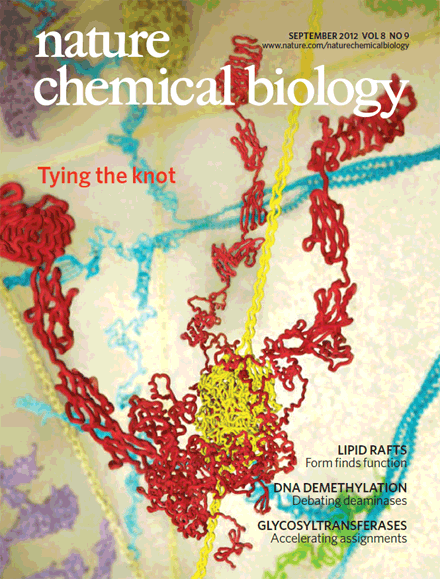
By Jessica Mazerik
Vanderbilt University professor Billy Hudson, Ph.D., and his lab have achieved a scientific “bleacher burner” — their paper is published, discussed in an editorial and featured on the cover of this month’s Nature Chemical Biology, a high profile journal.
“This is our first experience with a home run,” said Hudson, Elliott V. Newman Professor of Medicine, director of the Center for Matrix Biology and the paper’s senior author.
Their report, published online on July 29, shows that the enzyme peroxidasin forms the sulfilimine chemical bonds that hold together the collagen IV networks of basement membranes. The findings have provided novel insight into the mechanisms that underlie kidney diseases.
Hudson’s group also discovered the sulfilimine chemical bond. Their report, published in Science magazine in 2009, changed the field of basement membrane biology by debunking the common belief that collagen IV molecules were held together by disulfide bonds.
“The research investigating the mechanism of collagen IV assembly has evolved over nearly two decades with continued work of my fellows and students,” said Hudson. “Our recent discovery of the sulfilimine bond made the question addressed in this paper quite obvious. What enzyme forms the bond?”

Hudson’s high scientific batting average had an unlikely beginning: He grew up in a small house in rural Grapevine, Ark., with no running water or electricity, and where daily work in the cotton fields trumped reading, studying and pursuit of education.
After dropping out of high school, several mentors helped Hudson find his way to science. Over the years, his lab has made groundbreaking discoveries that have enhanced understanding of basic basement

membrane biology, tissue genesis and kidney disease progression.
Hudson demonstrates his commitment to science education through his work with the Aspirnaut Initiative, a program that he and his wife, Julie Hudson, M.D., Assistant Vice Chancellor of Health Affairs at Vanderbilt, founded in 2006.
The program is funded by donations and the National Institutes of Health (NIH) and provides science education and research opportunities for rural elementary and high school students in Arkansas, Tennessee and Maine.
Hudson attributed his team’s “home run” to preparation, talent and Vanderbilt’s supportive environment.
“I am keenly aware that this accomplishment is based on several critical factors including a well-crafted question, talented and motivated fellows, students and staff, a supportive environment and superior core facilities — all of which exist at Vanderbilt,” he said.
The study was supported by the National Institute of Diabetes and Digestive and Kidney Diseases (NIDDK) of the NIH (grants RO1 DK018381 and PO1 DK065123). The Aspirnaut program is supported by PO1 DK065123 and by an NIDDK Step Up grant.
Media contact: Bill Snyder, (615) 322-4747
william.snyder@vanderbilt.edu